[English] 日本語
 Yorodumi
Yorodumi- PDB-7cj0: Crystal structure of DNAJC9 HBD in complex with H3.3-H4 dimer and... -
+ Open data
Open data
- Basic information
Basic information
| Entry | Database: PDB / ID: 7cj0 | ||||||||||||
|---|---|---|---|---|---|---|---|---|---|---|---|---|---|
| Title | Crystal structure of DNAJC9 HBD in complex with H3.3-H4 dimer and MCM2 HBD | ||||||||||||
 Components Components |
| ||||||||||||
 Keywords Keywords | CHAPERONE / Histone chaperone | ||||||||||||
| Function / homology |  Function and homology information Function and homology informationSwitching of origins to a post-replicative state / Unwinding of DNA / negative regulation of chromosome condensation / Barr body / : / nuclear origin of replication recognition complex / Regulation of MITF-M-dependent genes involved in DNA replication, damage repair and senescence / CMG complex / pericentric heterochromatin formation / inner kinetochore ...Switching of origins to a post-replicative state / Unwinding of DNA / negative regulation of chromosome condensation / Barr body / : / nuclear origin of replication recognition complex / Regulation of MITF-M-dependent genes involved in DNA replication, damage repair and senescence / CMG complex / pericentric heterochromatin formation / inner kinetochore / positive regulation of ATP-dependent activity / MCM complex / muscle cell differentiation / double-strand break repair via break-induced replication / mitotic DNA replication initiation / oocyte maturation / protein folding chaperone complex / regulation of DNA-templated DNA replication initiation / nucleosomal DNA binding / nucleus organization / DNA replication origin binding / cochlea development / spermatid development / DNA replication initiation / Activation of the pre-replicative complex / single fertilization / subtelomeric heterochromatin formation / Activation of ATR in response to replication stress / RNA polymerase II core promoter sequence-specific DNA binding / negative regulation of megakaryocyte differentiation / protein localization to CENP-A containing chromatin / Replacement of protamines by nucleosomes in the male pronucleus / CENP-A containing nucleosome / Packaging Of Telomere Ends / heat shock protein binding / Recognition and association of DNA glycosylase with site containing an affected purine / Cleavage of the damaged purine / embryo implantation / Deposition of new CENPA-containing nucleosomes at the centromere / Recognition and association of DNA glycosylase with site containing an affected pyrimidine / Cleavage of the damaged pyrimidine / cellular response to interleukin-4 / telomere organization / DNA helicase activity / Inhibition of DNA recombination at telomere / RNA Polymerase I Promoter Opening / Meiotic synapsis / Assembly of the ORC complex at the origin of replication / SUMOylation of chromatin organization proteins / Regulation of endogenous retroelements by the Human Silencing Hub (HUSH) complex / DNA methylation / Condensation of Prophase Chromosomes / Chromatin modifications during the maternal to zygotic transition (MZT) / SIRT1 negatively regulates rRNA expression / HCMV Late Events / ERCC6 (CSB) and EHMT2 (G9a) positively regulate rRNA expression / PRC2 methylates histones and DNA / Regulation of endogenous retroelements by KRAB-ZFP proteins / Defective pyroptosis / Assembly of the pre-replicative complex / HDACs deacetylate histones / Regulation of endogenous retroelements by Piwi-interacting RNAs (piRNAs) / Nonhomologous End-Joining (NHEJ) / RNA Polymerase I Promoter Escape / Transcriptional regulation by small RNAs / Formation of the beta-catenin:TCF transactivating complex / Activated PKN1 stimulates transcription of AR (androgen receptor) regulated genes KLK2 and KLK3 / RUNX1 regulates genes involved in megakaryocyte differentiation and platelet function / HDMs demethylate histones / G2/M DNA damage checkpoint / NoRC negatively regulates rRNA expression / DNA Damage/Telomere Stress Induced Senescence / B-WICH complex positively regulates rRNA expression / PKMTs methylate histone lysines / Meiotic recombination / Pre-NOTCH Transcription and Translation / multicellular organism growth / male gonad development / RMTs methylate histone arginines / Activation of anterior HOX genes in hindbrain development during early embryogenesis / Orc1 removal from chromatin / Transcriptional regulation of granulopoiesis / HCMV Early Events / osteoblast differentiation / structural constituent of chromatin / nucleosome / nucleosome assembly / single-stranded DNA binding / Recruitment and ATM-mediated phosphorylation of repair and signaling proteins at DNA double strand breaks / protein-folding chaperone binding / HATs acetylate histones / RUNX1 regulates transcription of genes involved in differentiation of HSCs / Factors involved in megakaryocyte development and platelet production / chromatin organization / MLL4 and MLL3 complexes regulate expression of PPARG target genes in adipogenesis and hepatic steatosis / Processing of DNA double-strand break ends / positive regulation of cell growth / Senescence-Associated Secretory Phenotype (SASP) / Oxidative Stress Induced Senescence / histone binding Similarity search - Function | ||||||||||||
| Biological species |  Homo sapiens (human) Homo sapiens (human) | ||||||||||||
| Method |  X-RAY DIFFRACTION / X-RAY DIFFRACTION /  SYNCHROTRON / SYNCHROTRON /  MOLECULAR REPLACEMENT / Resolution: 2.5 Å MOLECULAR REPLACEMENT / Resolution: 2.5 Å | ||||||||||||
 Authors Authors | Bao, H. / Huang, H. | ||||||||||||
| Funding support |  China, 3items China, 3items
| ||||||||||||
 Citation Citation |  Journal: Mol.Cell / Year: 2021 Journal: Mol.Cell / Year: 2021Title: DNAJC9 integrates heat shock molecular chaperones into the histone chaperone network. Authors: Hammond, C.M. / Bao, H. / Hendriks, I.A. / Carraro, M. / Garcia-Nieto, A. / Liu, Y. / Reveron-Gomez, N. / Spanos, C. / Chen, L. / Rappsilber, J. / Nielsen, M.L. / Patel, D.J. / Huang, H. / Groth, A. | ||||||||||||
| History |
|
- Structure visualization
Structure visualization
| Structure viewer | Molecule:  Molmil Molmil Jmol/JSmol Jmol/JSmol |
|---|
- Downloads & links
Downloads & links
- Download
Download
| PDBx/mmCIF format |  7cj0.cif.gz 7cj0.cif.gz | 249.5 KB | Display |  PDBx/mmCIF format PDBx/mmCIF format |
|---|---|---|---|---|
| PDB format |  pdb7cj0.ent.gz pdb7cj0.ent.gz | 201.9 KB | Display |  PDB format PDB format |
| PDBx/mmJSON format |  7cj0.json.gz 7cj0.json.gz | Tree view |  PDBx/mmJSON format PDBx/mmJSON format | |
| Others |  Other downloads Other downloads |
-Validation report
| Summary document |  7cj0_validation.pdf.gz 7cj0_validation.pdf.gz | 498.7 KB | Display |  wwPDB validaton report wwPDB validaton report |
|---|---|---|---|---|
| Full document |  7cj0_full_validation.pdf.gz 7cj0_full_validation.pdf.gz | 503.5 KB | Display | |
| Data in XML |  7cj0_validation.xml.gz 7cj0_validation.xml.gz | 22.6 KB | Display | |
| Data in CIF |  7cj0_validation.cif.gz 7cj0_validation.cif.gz | 30.7 KB | Display | |
| Arichive directory |  https://data.pdbj.org/pub/pdb/validation_reports/cj/7cj0 https://data.pdbj.org/pub/pdb/validation_reports/cj/7cj0 ftp://data.pdbj.org/pub/pdb/validation_reports/cj/7cj0 ftp://data.pdbj.org/pub/pdb/validation_reports/cj/7cj0 | HTTPS FTP |
-Related structure data
| Related structure data |  7cizC  5bnvS S: Starting model for refinement C: citing same article ( |
|---|---|
| Similar structure data |
- Links
Links
- Assembly
Assembly
| Deposited unit | 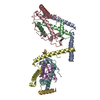
| ||||||||
|---|---|---|---|---|---|---|---|---|---|
| 1 | 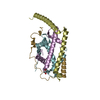
| ||||||||
| 2 | 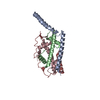
| ||||||||
| Unit cell |
|
- Components
Components
-Protein , 4 types, 8 molecules EBFCGHDA
| #1: Protein | Mass: 9026.496 Da / Num. of mol.: 2 Source method: isolated from a genetically manipulated source Source: (gene. exp.)  Homo sapiens (human) / Gene: H3-3A, H3.3A, H3F3, H3F3A, PP781, H3-3B, H3.3B, H3F3B / Production host: Homo sapiens (human) / Gene: H3-3A, H3.3A, H3F3, H3F3A, PP781, H3-3B, H3.3B, H3F3B / Production host:  #2: Protein | Mass: 11263.231 Da / Num. of mol.: 2 Source method: isolated from a genetically manipulated source Source: (gene. exp.)  Homo sapiens (human) Homo sapiens (human)Gene: HIST1H4A, H4/A, H4FA, HIST1H4B, H4/I, H4FI, HIST1H4C, H4/G, H4FG, HIST1H4D, H4/B, H4FB, HIST1H4E, H4/J, H4FJ, HIST1H4F, H4/C, H4FC, HIST1H4H, H4/H, H4FH, HIST1H4I, H4/M, H4FM, HIST1H4J, H4/E, ...Gene: HIST1H4A, H4/A, H4FA, HIST1H4B, H4/I, H4FI, HIST1H4C, H4/G, H4FG, HIST1H4D, H4/B, H4FB, HIST1H4E, H4/J, H4FJ, HIST1H4F, H4/C, H4FC, HIST1H4H, H4/H, H4FH, HIST1H4I, H4/M, H4FM, HIST1H4J, H4/E, H4FE, HIST1H4K, H4/D, H4FD, HIST1H4L, H4/K, H4FK, HIST2H4A, H4/N, H4F2, H4FN, HIST2H4, HIST2H4B, H4/O, H4FO, HIST4H4 Production host:  #3: Protein | Mass: 7860.354 Da / Num. of mol.: 2 Source method: isolated from a genetically manipulated source Source: (gene. exp.)  Homo sapiens (human) / Gene: MCM2 / Production host: Homo sapiens (human) / Gene: MCM2 / Production host:  #4: Protein | Mass: 9455.661 Da / Num. of mol.: 2 / Mutation: C243S Source method: isolated from a genetically manipulated source Source: (gene. exp.)  Homo sapiens (human) / Gene: DNAJC9 / Production host: Homo sapiens (human) / Gene: DNAJC9 / Production host:  |
|---|
-Non-polymers , 2 types, 70 molecules 


| #5: Chemical | ChemComp-GOL / |
|---|---|
| #6: Water | ChemComp-HOH / |
-Details
| Has ligand of interest | N |
|---|
-Experimental details
-Experiment
| Experiment | Method:  X-RAY DIFFRACTION / Number of used crystals: 1 X-RAY DIFFRACTION / Number of used crystals: 1 |
|---|
- Sample preparation
Sample preparation
| Crystal | Density Matthews: 2.67 Å3/Da / Density % sol: 58.48 % Description: THE ENTRY CONTAINS FRIEDEL PAIRS IN I/F_PLUS/MINUS COLUMNS. |
|---|---|
| Crystal grow | Temperature: 293 K / Method: vapor diffusion, sitting drop Details: 0.17 M Sodium acetate, 0.1 M Tris, pH8.5, 25% (v/v) PEG 4000, 20% (v/v) Glycerol |
-Data collection
| Diffraction | Mean temperature: 100 K / Serial crystal experiment: N | ||||||||||||||||||
|---|---|---|---|---|---|---|---|---|---|---|---|---|---|---|---|---|---|---|---|
| Diffraction source | Source:  SYNCHROTRON / Site: SYNCHROTRON / Site:  SSRF SSRF  / Beamline: BL17U1 / Wavelength: 0.9792 Å / Beamline: BL17U1 / Wavelength: 0.9792 Å | ||||||||||||||||||
| Detector | Type: DECTRIS EIGER X 16M / Detector: PIXEL / Date: Nov 23, 2017 | ||||||||||||||||||
| Radiation | Protocol: SINGLE WAVELENGTH / Monochromatic (M) / Laue (L): M / Scattering type: x-ray | ||||||||||||||||||
| Radiation wavelength | Wavelength: 0.9792 Å / Relative weight: 1 | ||||||||||||||||||
| Reflection twin | Operator: -h,-k,l / Fraction: 0.13 | ||||||||||||||||||
| Reflection | Resolution: 2.24→41.084 Å / Num. obs: 41413 / % possible obs: 99.9 % / Redundancy: 17.3 % / Rmerge(I) obs: 0.086 / Net I/σ(I): 17.7 | ||||||||||||||||||
| Reflection shell |
|
- Processing
Processing
| Software |
| ||||||||||||||||||||||||||||||||||||||||||||||||||||||||||||||||||||||||||||||||||||
|---|---|---|---|---|---|---|---|---|---|---|---|---|---|---|---|---|---|---|---|---|---|---|---|---|---|---|---|---|---|---|---|---|---|---|---|---|---|---|---|---|---|---|---|---|---|---|---|---|---|---|---|---|---|---|---|---|---|---|---|---|---|---|---|---|---|---|---|---|---|---|---|---|---|---|---|---|---|---|---|---|---|---|---|---|---|
| Refinement | Method to determine structure:  MOLECULAR REPLACEMENT MOLECULAR REPLACEMENTStarting model: 5BNV Resolution: 2.5→41.08 Å / Cross valid method: THROUGHOUT / σ(F): 32.39 / Phase error: 34.6 / Stereochemistry target values: TWIN_LSQ_F
| ||||||||||||||||||||||||||||||||||||||||||||||||||||||||||||||||||||||||||||||||||||
| Solvent computation | Shrinkage radii: 0.9 Å / VDW probe radii: 1.11 Å / Solvent model: FLAT BULK SOLVENT MODEL | ||||||||||||||||||||||||||||||||||||||||||||||||||||||||||||||||||||||||||||||||||||
| Displacement parameters | Biso max: 162.75 Å2 / Biso mean: 81.1957 Å2 / Biso min: 29.62 Å2 | ||||||||||||||||||||||||||||||||||||||||||||||||||||||||||||||||||||||||||||||||||||
| Refinement step | Cycle: final / Resolution: 2.5→41.08 Å
| ||||||||||||||||||||||||||||||||||||||||||||||||||||||||||||||||||||||||||||||||||||
| Refine LS restraints |
| ||||||||||||||||||||||||||||||||||||||||||||||||||||||||||||||||||||||||||||||||||||
| LS refinement shell | Refine-ID: X-RAY DIFFRACTION / Rfactor Rfree error: 0 / Total num. of bins used: 11
|
 Movie
Movie Controller
Controller




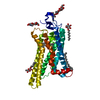
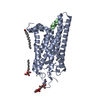



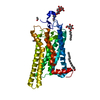

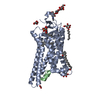
 PDBj
PDBj














